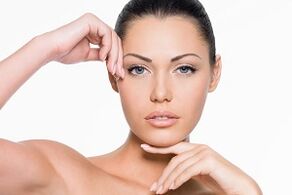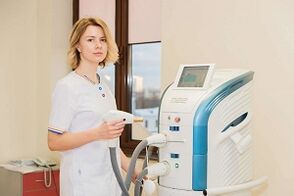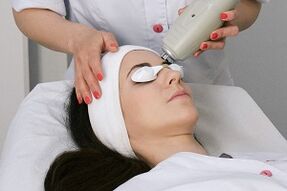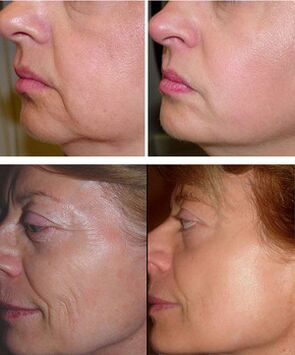
Facial skin inevitably undergoes a natural aging process, which can be resisted by modern cosmetics and cosmetic procedures.
One of these procedures — laser rejuvenation — uses techniques to rejuvenate and regenerate cells, leaving the skin looking younger, fresher, and more beautiful.
In cosmetology, a special laser is used to treat various skin problems. Fractional laser skin rejuvenation is a popular cosmetic procedure, after which you can increase the elasticity of the skin, remove fine and deep wrinkles and strengthen the oval face. Looks a few years younger after completing the course of the sessions.
The essence and impact of technology

Laser skin rejuvenation is a method of laser irradiation of the skin. To do this, a laser source is used - a laser installation - a device that can adjust the depth of absorption of laser light into the skin, the duration of exposure and the temperature of the radiation.
Choosing the right parameters of the procedure is the most important condition for successful rejuvenation, because a small mistake of a cosmetologist can cause burns on the face.
The laser light penetrates the tissue and causes some damage to the cells. In response to the irritation, the cells actively produce collagen and elastin, and the growth of new cells resumes.
Stimulation of regeneration processes leads to a complete renewal of the skin, its rejuvenation. The second name of the procedure is laser peeling.
Indications and contraindications
Techniques are used to eliminate such age-related changes in facial skin:
- Wrinkles.
- Black spots.
- Leafy and drooping.
Also instructions for the procedure:
- Scars and bumps on the face.
- Traces of heat on the face.
- Unwanted tattoos.
- Keratinization of the skin.
- The pores are enlarged.
- The vascular network on the face.
- Symptoms lasting in the abdomen and legs after pregnancy.
Guidelines against laser peeling:
- Keloid scars.
- Malignant tumors.
- Pregnancy, lactation.
- Acute herpes infection.
- Wounds and abrasions on the face.
- Various skin diseases.
- Fresh tan.
- Moles.
- Acne treatment.
In most cases, laser rejuvenation is uncomplicated, and in the first days after the procedure, the patient notices a slight swelling, redness and peeling of the epidermis. These symptoms are normal for laser peeling and go away on their own after a few days.
Possible side effects

However, in some cases the following side effects may occur:
- Persistent redness of the face.
- Exacerbation of facial heat.
- Increase skin oiliness.
- Occurrence of hyper- or hypopigmentation.
- Herpetic eruptions (if the patient has previously been diagnosed with herpes).
- Burns.
- Maintain the boundary between treated and untreated areas of skin.
- Bleeding under the skin.
The side effects listed will disappear for a long time and require additional treatment by a cosmetologist.
Advantages and disadvantages of peeling
Fractional shells are widely used due to the following advantages:
- High efficiency, the ability to eliminate significant aesthetic shortcomings.
- Possibility to carry on different skin types.
- Minimal risk of side effects (burns and hyperpigmentation).
- Painlessness.
- Short skin rejuvenation periods.
- Possibility to treat large areas of skin in the same way.
The disadvantage of fractional peeling is its high cost compared to other methods, but given the effectiveness of the procedure, this shortcoming can be considered insignificant.
Types of laser rejuvenation
There are several types of laser rejuvenation depending on the depth:

- Laser coating. . . The laser "works" in the upper layer of the epidermis and removes dead cells. The effect of the procedure is noticeable after a week: the skin is velvety and small wrinkles disappear. Three types of laser beams are used during the procedure: erbium, carbon, or neodymium.
- Laser biorevitalization. . . Radiation penetrates the deeper layers of the skin and destroys some cells. The technique is tougher than the surface of the laser, but has a stronger anti-aging effect. To enhance the effect of the laser, the cosmetologist uses a mixture of nutrients on the skin. After the procedure, deep wrinkles disappear and facial contours improve. Recovery after biorevitalization takes place within three months, during which time the epidermis on the surface may become swollen and severely peeled.
- Fractional peeling. . . Fractional laser rejuvenation is the most effective and at the same time gentle method. The peculiarity of the procedure is that the laser light is divided into many micro-rays, which has a gentle effect on the skin. Radiation strikes the skin in the form of a grid, so the whole area remains between the foci of cellular damage - this promotes rapid tissue regeneration and a strong rejuvenating effect. During fractional peeling, the strength of the beam can be changed using a carbon dioxide or erbium laser.
Stages of the procedure
Before performing the procedure, you should see a cosmetologist. The doctor identifies current problems, asks the patient if there are any contraindications to the procedure, talks about laser rejuvenation.
If the patient's skin pigmentation is severe, a whitening cream is prescribed a few days before the rejuvenation session. Before the procedure, the patient should know that he should not exercise, do hard physical work, or drink alcohol.
Sequence of fractional peeling:
- The face is cleansed using regular cosmetics.
- An anesthetic cream is applied to the skin.
- After a few minutes, the anesthesia is washed off and a gel is applied to facilitate the movement of the nozzle of the fractional apparatus. The patient wears glasses.
- The doctor moves the nozzle to the face, using a laser to consistently affect each area.
- The treatment lasts 15-60 minutes, after which a soothing cream is applied to the skin.
In general, you need to go through 3-4 procedures, with a break between them is 1-2 months.
Skin care at home

After laser treatment, the skin develops swelling, redness, peeling and itching, and later peeling. Patients should follow these recommendations:
- Apply a cold compress to the face to remove the swelling.
- Apply anti-inflammatory and soothing creams on the skin (prescribed by a cosmetologist).
- Apply sunscreen on your face before going out.
- Do not go to the bath, sauna or hot tub for two weeks after the procedure.
- Do not use scrubs; Use cosmetics only with the permission of a cosmetologist.
- To prevent scarring on the face, do not remove the peels.
If the laser rejuvenation is performed by a highly qualified specialist and the patient follows all the recommendations of the doctor, then the result of the procedure will be pleasing with an excellent cosmetic effect.














































































